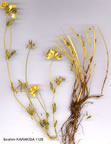| Fabaceae |
 Lotus corniculatus var. tenuifolius |
| Lotus L. Lotus corniculatus L. var. tenuifolius L. Ömür: Çok yıllık Yapı: ot Hayat formu: İlk çiçeklenme zamanı: 4 Son çiçeklenme zamanı: 9 Habitat: yaş, ağır topraklar üzerinde, nehir kıyılarında ve bataklıklarda Minimum yükseklik: 0 Maksimum yükseklik: 2750 Endemik: - Element: ? Türkiye dağılımı: Anadolu Genel dağılımı: Avrupa, K. Afrika, B. ve O. Asya Bulunduğu kareler :A1 A2 A3 A4 A5 A6 A7 A8 A9 B1 B2 B3 B4 B5 B6 B7 B8 B9 B10 C2 C3 C4 C5 C6 C8 C9 C10 |
| L. corniculatus L., Sp. PI. 776 (1753). Zertova, op. cit. (1967). Glabrous to pubescent perennial, decumbent, ascending or erect, not stoloni-ferous, stems up to 50 cm, solid. Leaflets (of the main stem) from narrow-lanceolate to lanceolate, oblanceolate or obovate, without evident lateral veins, varying in size. Umbels 1-7-flowered, on peduncles much longer than subtending leaves. Bracts usually 3, narrow and short, about as long as calyx. Flowers (7-)9-13(-15) mm. Calyx subcampanulate. with teeth c. 1-1½ x tube. Corolla about 2 x calyx, yellow to goiden-yellow, often turning green on drying, sometimes red; standard longer than keel and wings, often red-veined: keel strongly arched, with fairly long beak, slightly longer than wings. Legume 15-30 x 1.5-2 mm, straight, terete. 2/7 = 12, 24. Fl. (4)5-8(9). The almost impossible task of the division of the L. corniculatus complex has been pointed out repeatedly. Many botanists have subdivided it into a large number of species which differ only very little from one another. Here L. corni-culatus is treated as a polymorphic species comprising a spectrum of different forms that can be provisionally grouped under three varieties, connected by intermediates. All three varieties occur in the Euro-Siberian, Mediterranean and Irano-Turanian regions, but usually grow in different habitats. 1. Upper leaflets obovate, obtuse or apiculate; umbels 2-7-flowered; flowers 8-15 mm; stems sturdy 2. Stems up to 20 cm; leaflets small, not exceeding 7 x 3 mm, usually ± densely hairy; umbels (l-)2-4-flowered; flowers 8-11 mm var. alpinus 2. Stems more than 20 cm; leaflets larger, usually sparsely hairy or subglabrous; umbels usually (3-)4-7-flowered; flowers 10-15 mm var. corniculatus 1. Upper leaflets narrowly oblong or oblanceolate, often subacuminate; umbels l-3(-5)-flowered; flowers 7-10 mm; stems slender var. tenuifolius var. tenuifolius L.,Sp. P1. 776(1753). Syn: L.tenuisKit. exWilld., Enum.Pl. Hort. Berol. 2:797 (1809); L. tenuifolius (L.) Reichb., Fl. Germ. Exc. 22:506(1832); Ic: Reichb., Ic. F1. Germ. 22: t. 130 (1903); Ross-Craig, Draw. Brit. PL 7: t. 44 (1954). Fl. 4-9. On damp, heavy soils, river banks and marshes, s.l,-2750 m. Described from Europe. Widespread throughout Anatolia, though rare in easternmost Anatolia. A1(E) Edirne: Ipsala, 50-100 m, D. 47804! A2(E) Istanbul: Küçük Çekmece, 25 vii 1939, B. Post! A2(A) Kocaeli: Istanbul-Izmit road, 55 km from Istanbul, 100 m, McNeill 226! A3 Zonguldak: Kozlu, Khan et al. 801! A4 Çankiri: nr. Çandir, D. 21442! A5 Amasya: SE of Merzifon, 630 m, M. Zohary 1170129! A7 Giresun: Kulakkaya to Tamdere, 1000-1050 m, Hub.-Mor. 15030. A8 Çoruh: above Artvin, 800 m, D. 30040! B2 Bursa: Tahtaköprü, 850 m, D. 36653! B3 Eskişehir: Konuklar, S of Eskişehir, Birand & M. Zohary 2549! B4 Ankara: Ankara, 9 vii 1932, Kotte! B6 Malatya: Gürün, 1070 m, D. 21893! B7 Erzincan: plain E of Erzincan, 1250 m, D. 31852! B8/C8 Bitlis: Diyarbakir to Bitlis, c. 1350 m, McNeill 497! C2 Muğla: 3 miles from Marmaris to Muğla, 150 m, D. 35491! C3 Antalya: Antalya, 3 m, Truman 239! C4 Konya: Konya to Kayacik, D. 14749! C5 Adana: Pozanti, Siehe 1896:376! C6 Hatay: 1-2 miles N of Iskenderun, s.l., D. 26951! Though easily distinguished in W. Europe (often as L. tenuis), in Turkey var. tenuifolius intergrades extensively with var. corniculatus. A specimen from A1(E) Edirne (Enez, Coode & Jones 2925!) approaches, in its long calyx teeth, the plant sometimes treated in Europe as L. preslii Ten. |